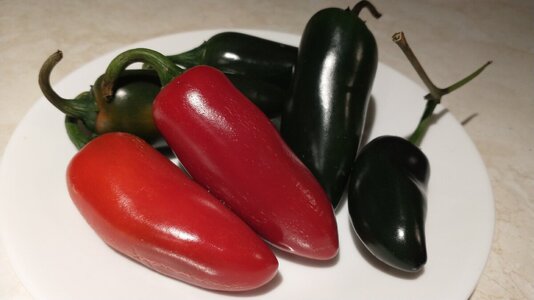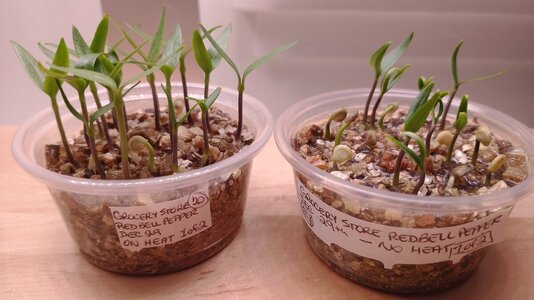Branching Out
Garden Addicted
Mid-January, and a couple of Siracha plants that are growing outdoors under cover are still ripening fruit. I picked all of these a couple of days ago. That was a welcome development, but it's not at all typical for our area. We're having an unusually warm, wet winter this year.
Over the past few years I've had some challenges starting pepper seeds, and I would like to find a method that will give me better results. So recently I've been doing a bunch of pepper germination experiments. This photo shows seedlings grown using seeds of a red bell pepper that was purchased at the grocery store. My experiment was to see if germinating the seeds at a slightly warmer temperature really makes much of a difference. I'm re-reading Nancy Bubel's book The Seed Starters Handbook, and she mentioned that not only do the pepper seeds germinate faster-- but the resulting seedlings are less likely to be deformed, or stunted. Well this little experiment certainly supports that theory. Initially I put 20 seeds in each cup. The container on the left went in a humidity dome on a heat mat at about 24C(75F), and the container on the right was left at room temperature to germinate (in our house 'room temperature' is about 20C(68F) during the day, and 17.5(63.5F)C at night time). At the two week mark there wasn't a very big difference between the development of the seeds in the two containers, but by the three week mark when I took this photo the difference was dramatic. I am quite shocked at how much healthier the seedlings look when they begin life with just a few extra degrees of heat. I think I'll repeat this experiment using some of the Siracha seeds, to see if I get similar results.
Over the past few years I've had some challenges starting pepper seeds, and I would like to find a method that will give me better results. So recently I've been doing a bunch of pepper germination experiments. This photo shows seedlings grown using seeds of a red bell pepper that was purchased at the grocery store. My experiment was to see if germinating the seeds at a slightly warmer temperature really makes much of a difference. I'm re-reading Nancy Bubel's book The Seed Starters Handbook, and she mentioned that not only do the pepper seeds germinate faster-- but the resulting seedlings are less likely to be deformed, or stunted. Well this little experiment certainly supports that theory. Initially I put 20 seeds in each cup. The container on the left went in a humidity dome on a heat mat at about 24C(75F), and the container on the right was left at room temperature to germinate (in our house 'room temperature' is about 20C(68F) during the day, and 17.5(63.5F)C at night time). At the two week mark there wasn't a very big difference between the development of the seeds in the two containers, but by the three week mark when I took this photo the difference was dramatic. I am quite shocked at how much healthier the seedlings look when they begin life with just a few extra degrees of heat. I think I'll repeat this experiment using some of the Siracha seeds, to see if I get similar results.


